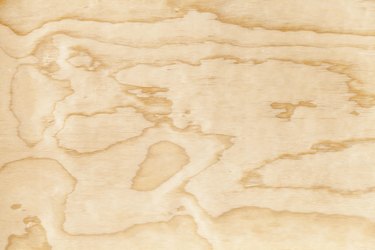
Plywood proves indispensable in the building and cabinetry trades, so carpenters, cabinetmakers and home hobbyists alike must be familiar with the standard sizes in which it is available. A standard sheet measures 4 by 8 feet and comes in a range of thicknesses, with specialty sizes also available.
Standard Widths and Lengths
Video of the Day
The widths and lengths of plywood sheets manufactured for use in the U.S. are measured in English units, while those manufactured for use in Europe, Canada, Japan and other countries that use the metric system are measured in metric units. The most common plywood sheet dimension, 4 feet by 8 feet, translates to the metric dimensions of 1,219 by 2,438 millimeters. Hardwood plywood comes also in abbreviated sheets measuring 2 by 2, 2 by 4, and 4 by 4 feet, while utility-grade plywood comes in longer 4-by-10-foot sheets. You can also buy oversized 5-foot-wide utility-grade plywood with lengths of 6, 8 and 10 feet. All but the oversized sheets are available in metric equivalents.
Video of the Day
Nominal and Actual Thicknesses
The nominal thicknesses of plywood range from 1/8 inch, or 3.2 mm, to 1 1/4 inches, which is equivalent to 31.75 mm. These often aren't the actual thicknesses, however, because sanding during manufacturing removes up to 1/32 inch of material. Thus, a plywood sheet with a nominal thickness of 3/8 inch is actually 11/32 inch thick. Standard nominal thicknesses include 1/8, 1/4, 3/8, 1/2, 5/8, 3/4, 1 1/8 and 1 1/4 inches. These correspond to actual thicknesses of 1/8, 1/4, 11/32, 15/32, 19/32, 23/32, 1 1/8 and 1 1/4 inches, respectively. In metric terms, the nominal thicknesses are 3, 6, 10, 13, 16, 19, 28 and 32 mm.
Size Tolerances
Plywood consists of thin sheets of softwood glued together in layers, with the wood grain of each layer perpendicular to the next. The outermost layers determine the grade, and sometimes use, of the material. Top grade -- or sanded -- plywood has an outer skin of quality hardwood or softwood, which is free of knots and defects. This is the preferred material of cabinetmakers and interior woodworkers. Its size tolerances -- especially for thickness -- are smaller that those for the utility-grade plywood used in the building trades for roof and wall sheathing, subfloors and general-use purposes. Tolerance for utility-grade thickness is 1/32 inch, and for cabinet-grade plywood, 1/64 inch.
Baltic Birch and Lauan Plywood
Baltic birch plywood is a particularly fine grade of plywood that is manufactured primarily for the European market. It comes in 5- by 5-foot sheets, and its nominal thicknesses, which are usually expressed in metric units, are 3, 6, 9, 12 and 18 mm, corresponding to 1/8, 1/4, 3/8, 1/2 and 3/4 inches. Plywood manufacturers use lauan -- sometimes called Philippine mahogany -- to make a utility-grade plywood for cabinetry and interior woodwork. It comes in standard 4- by 8-foot sheets with thicknesses of 1/8, 1/4, 5/16 and 3/4 inches.